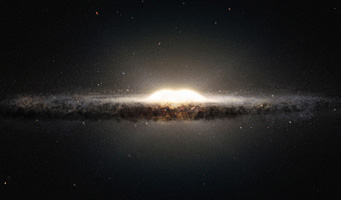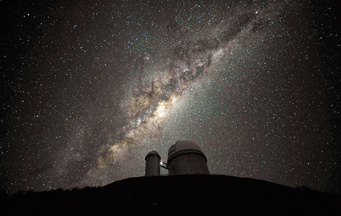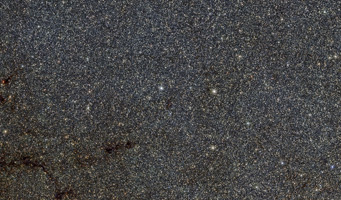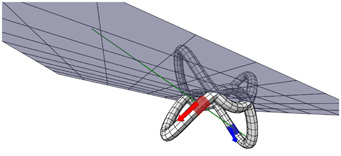New 3D maps of the Milky Way's central bulge of stars show a distinctively peanut-like shape. The maps give clues about how our galaxy evolved to its present-day form.

An extra-galactic alien view of the Milky Way shows a peanut-shaped bulge of stars at its center.
ESO / NASA / JPL-Caltech / M. Kornmesser / R. Hurt
It’s hard to tell how an airplane flies when you’re sitting inside one. Similarly, it’s difficult to tease apart the dynamics of the galaxy you belong to. But in an airplane (at least a few years ago), you wouldn’t be surprised to find a peanut.
It turns out that the Milky Way also has a peanut inside: the galaxy’s central bulge, which contains 10 billion Suns worth of stars, is shaped like one. Two recently released 3D maps of the bulge outline its peculiar shape and tie it to our galaxy’s history.
Mapping the Bulge: Peanuts and Bananas

The Milky Way bulge, shown here above the 3.6-meter telescope at La Silla Observatory in Chile, lies 27,000 light-years away. Dust enshrouds much of the central bulge, obscuring observations.
ESO / S. Brunier
The Milky Way is a striking celestial sight as much for its dark bands of dust as for its milky river of starlight. Those dust bands block much of the visible light from view. So to make sense of our galaxy’s bustling downtown, Christopher Wegg and Ortwin Gerhard (Max Planck Institute for Extraterrestrial Physics, Germany) looked to VISTA Variables in Via Lactea (VVV), a near-infrared survey that pierces the dusty veil to image individual, faraway stars along the galaxy’s plane.
Wegg and Gerhard plucked 22 million “red clump” giants from the survey, stars in the twilight of their lives that burn helium rather than hydrogen in their cores. These stars should all have the same absolute brightness. By measuring how bright the stars appear to be, astronomers can calculate how far away they are.

Zooming in on Milky Way's bulge shows this star-filled patch of sky, which is but a tiny part of the VISTA Variables in Via Lactea (VVV) survey.
ESO / VVV Survey / D. Minniti / I. Toledo
Wegg and Gerhard counted the number of red clump stars in each section of the bulge to map out the whole center in three dimensions. Their map shows the bulge has a distinctly peanut-like shape. Previous surveys had found peanut-shaped hints before, but this was the first survey to collect data without assuming a model for the bulge’s shape.
How does the peanut-like bulge take shape? Through banana-like orbits, of course. Another recently released study, this one by Sergio Vásquez (Pontifical Catholic University of Chile) and colleagues, took on the challenging task of mapping the motions of bulge stars. Comparing images of the galactic center taken 11 years apart from the 2.2-meter telescope at La Silla Observatory in Chile, Vásquez’s team tracked the movements of 454 red clump giant stars.
What they found was expected from models of our galaxy’s evolution, yet nevertheless completely bizarre: half the stars follow banana-shaped orbits that plunge them in and out of the galactic center as if they were on a giant swing.
A Buckling Bulge
Both of these studies suggest a peaceful history for our galaxy, an evolution on its own rather than by colliding and merging with another big galaxy. Gravitational interaction between stars rotating in the disk created the central bulge, initially shaped like a squashed football.
But this bar-shaped bulge wasn’t gravitationally stable — it buckled, sending stars on banana-like orbits that gave the bulge its distinctive peanut shape. Such weird orbits seem like they ought to be impossible, or at least unstable, but they're actually maintained by the gravitational field associated with the Milky Way's rectangular bulge.

About half the stars in the Milky Way's bulge travel along banana-shaped orbits that take them in and out of the galaxy's plane. This sketch shows two such banana-like trajectories, outlining the peanut-shaped bulge. The red and blue arrows refer to the bright and faint red clump stars, respectively, observed by Vásquez's team. The Milky Way's plane is shown in gray.
Courtesy Sergio Vásquez
“Much of the physics of buckling or bending instability is due to what is known as the ‘firehose instability,’” Wegg explains. “When the water flow from the hose is high, it will violently throw itself from side to side . . . The stars moving rapidly along the initially thin bar are like water travelling quickly through the fire hose.”
As the galaxy’s central bar became wider and therefore more stable, it stopped thrashing about, like a fire hose with a wider nozzle. But the stars set on banana-like orbits continued following them.
The buckling instability doesn’t quite explain everything, though. Vásquez’s stellar motion picture showed that half the red clump stars continue on regular, circular orbits around the galactic center. Current models say the buckling instability ought to have sent all the central stars on wacky orbits, so it’s not clear why so many managed to maintain normalcy.
Watch a simulation of the buckling instability here. (The bar in this simulated galaxy buckles once at around 2.4 billion years, abbreviated 2.4 Gyr in the video, and again around 7 billion years. The end result is a thicker, peanut-shaped bulge.)
 7
7
Comments
Justin S
September 18, 2013 at 10:59 am
That's fascinating!
I really love that picture of the observatory with the galaxy in the background!
You must be logged in to post a comment.
Pete
September 18, 2013 at 6:10 pm
Banana shaped orbits? What bends the elipse? You haven't explained that to any reasonable degree. I can fathom many different inclinations of elipsoidal orbits around the galactic center, and such would explain a peanut-shaped center volume. But to bend an elipsoidal orbit into a "U" shape would require forces that have not been identified in your article.
Water hose oscillations? But a water hose, as described, has an open and unrestrained end. There is no such open, unrestrained end to an orbit.
Someone has been eating too many bananas!
Respectfully,
Pete in Connecticut
You must be logged in to post a comment.
Justin S
September 18, 2013 at 6:20 pm
Satellites, planets, stars, etc. follow orbits that are conic sections (circle, ellipse, parabola, hyperbola) only when they orbit a gravitational field that is spherically symmetrical. The bulge has a flattened shape and the gravitational field of the galactic disk result in a strangely shaped gravitational field. It was calculated some years ago that stars orbiting close to the central galactic bulge would follow “banana” shaped orbits. Globular clusters and massive gas/dust clouds complicate this even more.
You must be logged in to post a comment.
Monica Young
September 18, 2013 at 8:50 pm
Hi Pete,
Justin S explains the matter well, and I've added a sentence along these lines to the article. Also, if you want to learn more about the bizarre orbits of stars in our galaxy, you might be interested in this applet from an astronomy course: http://burro.astr.cwru.edu/JavaLab/SOSweb/backgrnd.html. The first two slides are the most relevant to your question, but the rest is interesting too.
~ Monica
You must be logged in to post a comment.
Anthony Barreiro
September 21, 2013 at 7:33 pm
Thanks Dr. Young for this interesting report and the link to the Case Western slides about non-Keplerian orbits. Makes my head spin. I have a hard enough time understanding the orbit of the Moon around the Earth and the orbit of the Earth and Moon around the Sun, let alone the orbit of our solar system around the galactic center! We're lucky to live in such a simple part of the galaxy, otherwise more college sophomores would fail their intro to astronomy courses.
You must be logged in to post a comment.
Ashton
September 22, 2013 at 11:41 pm
I'm confused as to what makes astronomers think the orbits bend as displayed in the picture. What would draw it up the the galactic core and then at the peak of pull what over powers that to pull it away from the core creating that U shaped orbit. Wouldn't it make more sense if two stars were like criss crossed hula hoops. The hula hoop would be in an X shape creating the peanut Shape core and it still would make sense with our laws of physics.
You must be logged in to post a comment.
Pete
November 5, 2013 at 8:25 pm
Where is the last comment I entered???????
You must be logged in to post a comment.
You must be logged in to post a comment.